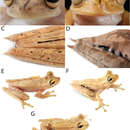ar
الأسماء في صفحات التنقل


The stained tree frog (Boana maculateralis) is a frog in the family Hylidae endemic to Ecuador, Colombia, and Peru. Scientists have seen it between 186 and 354 meters above sea level.[1][2]
This is a medium-sized frog with large eyes and large climbing disks on its toes. The adult male frog measures 31.9 to 39.2 mm in snout-vent length and the adult female frog is 32.0 to 55.3 mm. It has light brown skin with darker marks. Some individuals have a single line from the head to the middle of the back. Some indidivudals have small brown spots. Larger females have blue coloration on their flanks. Males have lighter or white coloration on their flanks. This frog has prominent spikes near its vent.[2]
This frog is sympatric with Boana calcarata, Boana alfaroi, Boana calcarata, and possibly Boana tetete.[2]
This frog is nocturnal. It lives in forests. Scientists have observed it perched on plants 2 meters above the ground.[2]
The Latin name of this frog means "stains on its sides."[2]
The stained tree frog (Boana maculateralis) is a frog in the family Hylidae endemic to Ecuador, Colombia, and Peru. Scientists have seen it between 186 and 354 meters above sea level.
This is a medium-sized frog with large eyes and large climbing disks on its toes. The adult male frog measures 31.9 to 39.2 mm in snout-vent length and the adult female frog is 32.0 to 55.3 mm. It has light brown skin with darker marks. Some individuals have a single line from the head to the middle of the back. Some indidivudals have small brown spots. Larger females have blue coloration on their flanks. Males have lighter or white coloration on their flanks. This frog has prominent spikes near its vent.
This frog is sympatric with Boana calcarata, Boana alfaroi, Boana calcarata, and possibly Boana tetete.
This frog is nocturnal. It lives in forests. Scientists have observed it perched on plants 2 meters above the ground.
The Latin name of this frog means "stains on its sides."
Hypsiboas maculateralis[1] es una especie de anfibio anuro de la familia Hylidae.
Esta especie se encuentra entre los 186 y 354 m sobre el nivel del mar en:
Los 22 especímenes machos adultos observados en la descripción original miden de 31 a 39 mm de longitud estándar y los 6 especímenes hembras adultas observadas en la descripción original miden de 32 y 55 mm de longitud estándar.
El epíteto específico maculateralis proviene del latín maculatus, manchado y de lateralis, lateral, con referencia a las manchas de color marrón oscuro en los flancos de esta especie.
Hypsiboas maculateralis est une espèce d'amphibiens de la famille des Hylidae[1].
Cette espèce se rencontre entre 186 et 354 m d'altitude[1] :
Sa présence est incertaine dans le sud de la Colombie.
Les 22 spécimens adultes mâles observés lors de la description originale mesurent entre 31,86 mm et 39,17 mm de longueur standard et les 6 spécimens adultes femelles observés lors de la description originale mesurent entre 32,04 mm et 55,31 mm de longueur standard[2].
L'épithète spécifique maculateralis vient du latin maculatus, maculé, et de lateralis, latéral, en référence aux taches brun foncé présentes sur les flancs de cette espèce[2].
Hypsiboas maculateralis est une espèce d'amphibiens de la famille des Hylidae.